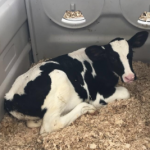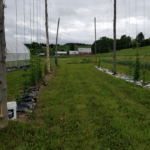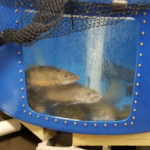The Office of Sustainability is pleased to announce that applications for the 2018-2019 Community Garden Internship are now open! Founded in 2010 from the efforts of a group of ENST 480 students and the Class gift of 2010, the Colgate Community Garden is now a half-acre vegetable and herb garden. We are looking for qualified students to help our Garden Manager, Beth Roy, not only manage and promote the garden, but also coordinate and organize volunteers and student work parties.
Garden interns should expect having to work in physically demanding, yet rewarding, conditions such as exposure to the outdoors and having to perform physically taxing activities. The internship has enabled past student garden interns to gain life-long skills and knowledge in harvesting and garden maintenance, event organization, and volunteer workers supervision.
“I’m very excited to see plants I planted grow and change through the course of the summer,” said Summer Cardarelli’21, one of the Summer 2018 Community garden interns, when she started working at the garden. Andrew Lapp’20, another Summer 2018 garden intern stated that assembling a caterpillar tunnel where they planted eggplants and tomatoes was a very enjoyable experience, and he thinks being a garden intern is ideal if you enjoy the outdoors.
The internship program involves a paid position starting around August 28th 2018 until early November 2018. Students of all class years and majors are welcome to apply. The expected work hours are 6 hours weekly. To apply, applicants should email their resume and a one-page cover letter (required), to Beth Roy, the Garden Manager at eroy@colgate.edu, and fill out the application on the Colgate Portal.
The application deadline is Friday, August 10th.
See the full job description below:
INTERNSHIP OVERVIEW AND PRIMARY RESPONSIBILITIES:
Interns will:
- Work with garden manager (Beth Roy) to plan and manage the garden during the fall season. Specific tasks may include preparing soil, cultivating, planting, weeding, and harvesting.
- Organize and supervise volunteer work parties.
- Coordinate with Green Thumbs presidents to schedule a weekly time for volunteer work parties and be at the garden during those scheduled times to supervise the work parties.
- Provide continuity for work on the garden throughout the 2018 growing season.
- Prepare for and help run a weekly Farm Stand to sell produce from the garden.
REQUIRED SKILLS AND EXPERIENCE
- Strong work ethic and self-motivated.
- Strong interpersonal and communication skills.
- Preference will be given to those with experience and firsthand knowledge in farming and/or gardening with vegetable crops; though previous garden experience is not required.
- Experience organizing and supervising the work of others.
- Tolerance for hard work and exposure to outdoor elements.
- Excitement about promoting local farming and local food production
For more information, visit the Colgate Portal or contact Beth Roy (eroy@colgate.edu), the Colgate Community Garden Manager and Consultant, or John Pumilio (jpumilio@colgate.edu) the Director of Sustainability.









